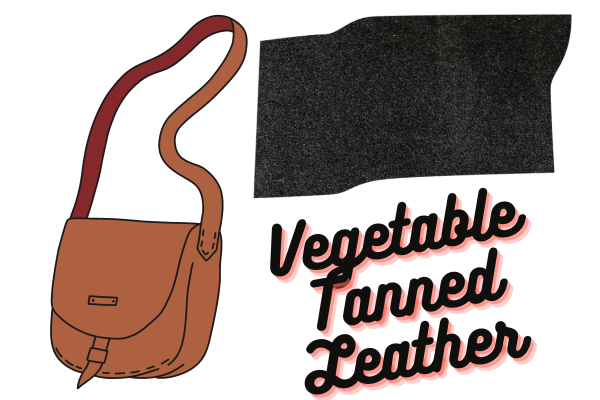Introduction
Among several things created from leather, Vegetable Tanned Leather is something amazing. It’s crafted using old traditional methods that people have used for a really long time. Here, we tell you the whole story about the uniqueness and other aspects related to this type of leather. A long time ago People a long time ago found out that if you use certain parts of plants on animal skins, you get something special. This way of making leather has been around for a very long time and has been used by different cultures.

The Beginnings of Vegetable Tanning
The comprehensive understanding of why vegetable tanning has been significant throughout history explains why people still cherish it in the present era. It has an old history, let’s start the story form the ancient times.
Discovery of the process (Ancient Origins)
Long time ago, our ancestors initially discovered the plants that could make animal hides very special. They found that when some particular plant elements applied to the animal skin, resulted in something remarkable. This revelation proved to be a game-changer, initiating the method of vegetable tanning.
Influence of Different Cultures (Cultural Influence)
People from diverse cultures around the world embraced vegetable tanning and made advancements in it over time. They added distinctive touches to the leather based on their own norms and traditions.
The Art of Making Vegetable Tanned Leather
This part reveals the complex process which transforms raw animal hides into flexible and long-lasting leather, using natural tannins.
Selection of Raw Materials (Choosing the Right Hides)
The basic step to start the complex process of vegetable tanning leather, is the selection of the right hides. Choosing the right hide with the particular animal species is essential to determine the final attributes of the leather product. Various types of hides have unique features such as grain pattern, thickness, and natural markings.
For instance, the hides from cattle might have a coarse surface, while those from goats or sheep can be smooth. The food of animals, their living conditions and their breed can also affect the standard, durability, flexibility and the possible development of the rich patina over time.
The Tanning Process: Unveiling the Transformation
Now, we reveal the journey form raw hide to final product, highlighting the crucial tanning process. This thoughtful process involves treating raw hides with tannins taken form plants. For transforming hides into leather and giving it desired qualities like flexibility and durability, this step is crucial
The tanning process is a delicate balancing act. Tannins have to soak into the hides, initiating a chemical reaction that strengthens and stabilizes the structure. This transformation converts the soft raw hides into durable leather. It isn’t just a technical step; it’s like a magical journey, turning natural materials into a practical and long lasting masterpiece.
For instance, the hides from cattle might have a coarse surface, while those from goats or sheep can be smooth. The food of animals, their living conditions and their breed can also affect the standard, durability, flexibility and the possible development of the rich patina over time.
Time and Patience
Being patient is crucial in vegetable tanning because it takes time for the tannins to do their magic on the hides. This lengthy process creates the unique qualities that make vegetable-tanned leather excellent. It ensures the durability and develops a unique patina as leather ages. For instance, the hides from cattle might have a coarse surface, while those from goats or sheep can be smooth. The food of animals, their living conditions and their breed can also affect the standard, durability, flexibility and the possible development of the rich patina over time.
Unique Attributes
It is famous for its remarkable qualities which make it unique from other leather kinds.
Aging Gracefully
You can observe the development of a rich patina as a result of the fascinating aging process of vegetable tanned leather. This ability not only adds a remarkable character but also tells the unique and graceful story of leather’s use over time.
Environmentally Conscious Approach of Vegetable Tanning
Vegetable tanning has been recognized for its environmental friendliness. This process depends on the natural tannins extracted from plants, that shows a sustainable and ecofriendly approach to leather production.
In this process, the components extracted from bark, leaves, or fruits are utilized to transform raw hides into leather. Unlike chemical tanning techniques that involve harsh and harmful chemicals, the use of natural tannins considerably reduces the ecological impact in comparison. Choosing vegetable tanning not only ensures the production of high quality leather but also promotes environmentally responsible practices. Moreover, it highly contributes to reducing the overall environmental footprint related to leather production. As it relies on renewable resources and avoids harsh chemicals, this makes the leather a preferred choice for consumers seeking sustainable alternatives.
Uses and Endurance
The vegetable tanned leather’s extensive utilization is attributed to its versatility and enduring durability, making it a favored material for multiple applications. Whether in fashion, accessories, or artisanal goods, its unique properties contribute to its preference in crafting enduring and high quality products.
Timeless Elegance in Fashion with Vegetable-Tanned Leather
In the evolving world of fashion, vegetable-tanned leather has been emerging as a prominent player as it contributes in making of classic items and accessories. It has become the first choice of the customers due to its durability and unique aging attributes. The lasting quality of vegetable-tanned leather adapts seamlessly in the creation of timeless fashion pieces.
Moreover, versatility of vegetable-tanned leather goes beyond its durability; it acts as a source for making a wide range of fashion items. From classic jackets to robust bags, belts, and a variety of accessories, this leather accommodates various styles and individual priorities.
Unveiling Artistry: Vegetable-Tanned Leather in Artisanal Goods
In the amazing world of handmade items, the skilled craftsmen use vegetable-tanned leather to make unique and personalized goods. Learn about the careful process behind making these special items, and see how the special qualities of vegetable-tanned leather make each piece authentic and skillfully crafted.
The Artisans in handmade products community use vegetable tanned leather as an essential part of their creations. Its special features, like aging gracefully and developing a unique patina, give the handmade products, a genuine feel.
The creation of handmade items is a careful process. Artisans thoughtfully select and cut the vegetable tanned leather, ensuring accuracy in every aspect. Moreover, the hand sewing and final touches highlight the uniqueness of each piece, creating a genuinely customized product.
Moreover, versatility of vegetable-tanned leather goes beyond its durability; it acts as a source for making a wide range of fashion items. From classic jackets to robust bags, belts, and a variety of accessories, this leather accommodates various styles and individual priorities.
Conclusion
Let’s conclude the discussion, we should acknowledge that the appeal of vegetable tanned leather is not just about its great quality. In fact, It’s about the fascinating history and the craftsmanship that’s woven into every piece. When we adopt this old school method, we connect ourselves to a heritage of skilled artisans who’ve honed their craft over generations. Each piece of the leather carries is not just a legacy of quality but also the story of the perfection of handmade art.
- You might be interested in reading this post as well
- What Is Crazy Horse Leather?
FAQs
• Yes, it is a wonderful option for using in items like wallets and belts. It is very durable and has the ability to develop a unique patina over time, making it lovely for daily use.
• Yes, because in vegetable tanning the natural tannins are extracted from plant matter. This method reduces the dependency on synthetic chemicals, making it more sustainable option.
• For maintaining vegetable tanned leather goods, it’s very important to place them away from moisture, harsh chemicals and direct heat.
• Vegetable-tanned leather is responsive to various dyes and finishes. Natural coloring and coatings can enhance its organic appeal are usually preferred. However, it’s crucial to follow proper methods in this regard.
• For the best and reliable results, it’s often better to let skilled professionals handle vegetable tanning because they know all the technicalities of this process.

